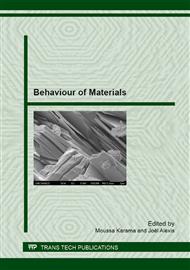p.41
p.49
p.57
p.63
p.71
p.79
p.85
p.91
p.99
Eddy Current Characterization of (Fe65Co35)xAl1-x Nanocrystalline Alloy Synthesized by Mechanical Alloying Process
Abstract:
An investigation was conducted to explore the applicability of Eddy Current (EC) and magnetic techniques to characterize the formation and grains size variation during Mechanical Alloying (MA) and the formation of a new mixture due to the variation of crystallography parameters. The change in apparent density was attributable to the irregular particles of the metal powders. A series of Nanocrystalline (Fe65Co35)xAl1-x samples have been prepared using M.A based on planetary ball mill under several milling conditions. M.A is a non-equilibrium process for materials synthesis. The structural effects of MA of powders were investigated by X-Ray diffraction analysis, SEM, microwaves, hysteresis magnetic and Eddy Current technique. Consequently, a nanostructure alloy was obtained with an average grain size of 8 nm. Experimental results show that fine nanocrystalline alloy powders prepared by mechanical milling are very promising for microwave applications and it is suggested that Eddy current measurement technique is a useful tool for the characterization of nanocrystalline materials.
Info:
Periodical:
Pages:
71-78
Citation:
Online since:
April 2013
Authors:
Keywords:
Price:
Сopyright:
© 2013 Trans Tech Publications Ltd. All Rights Reserved
Share:
Citation:


